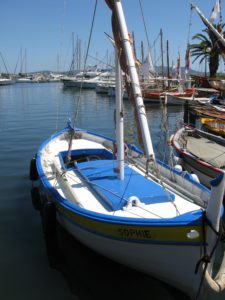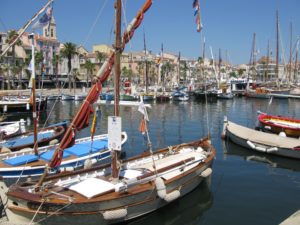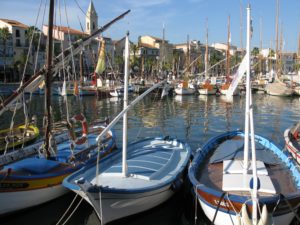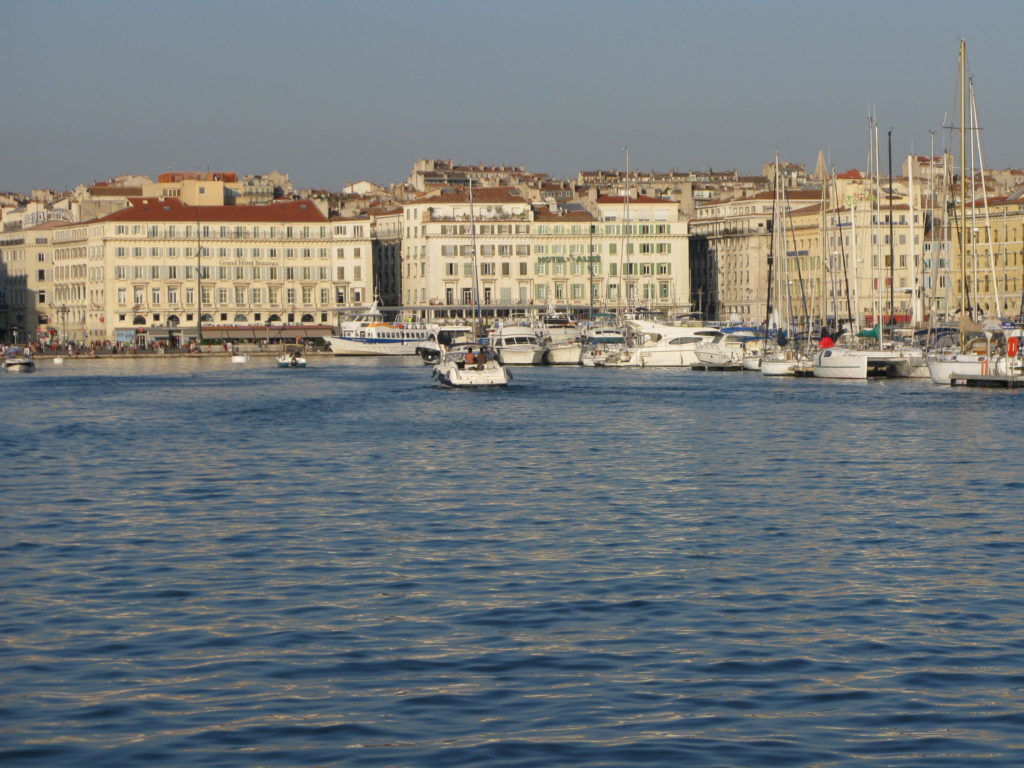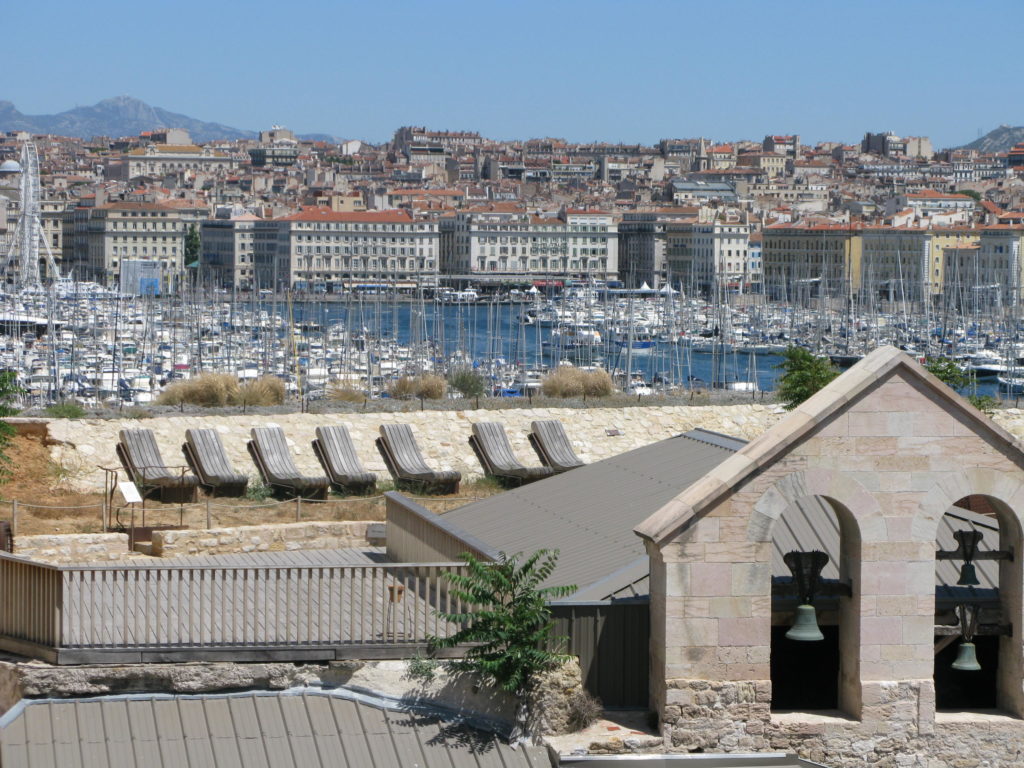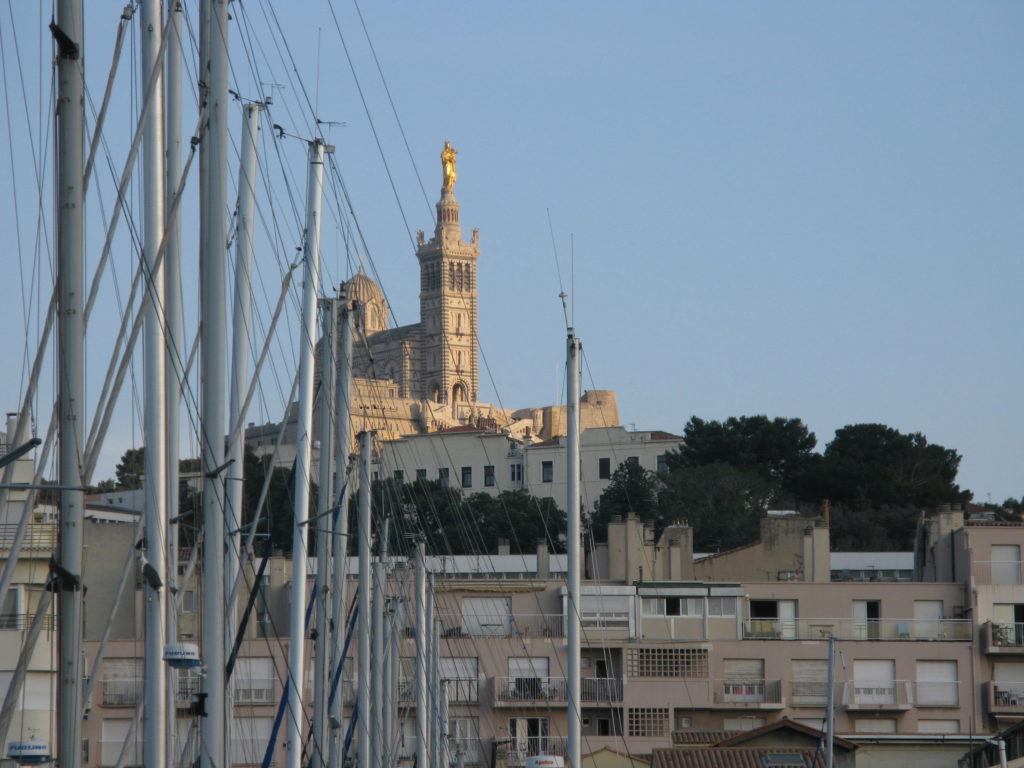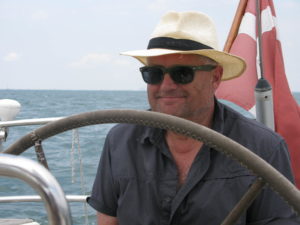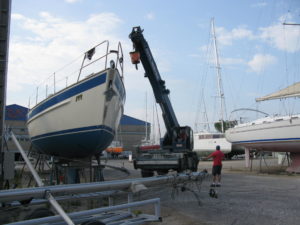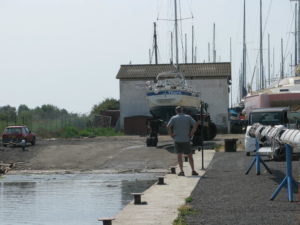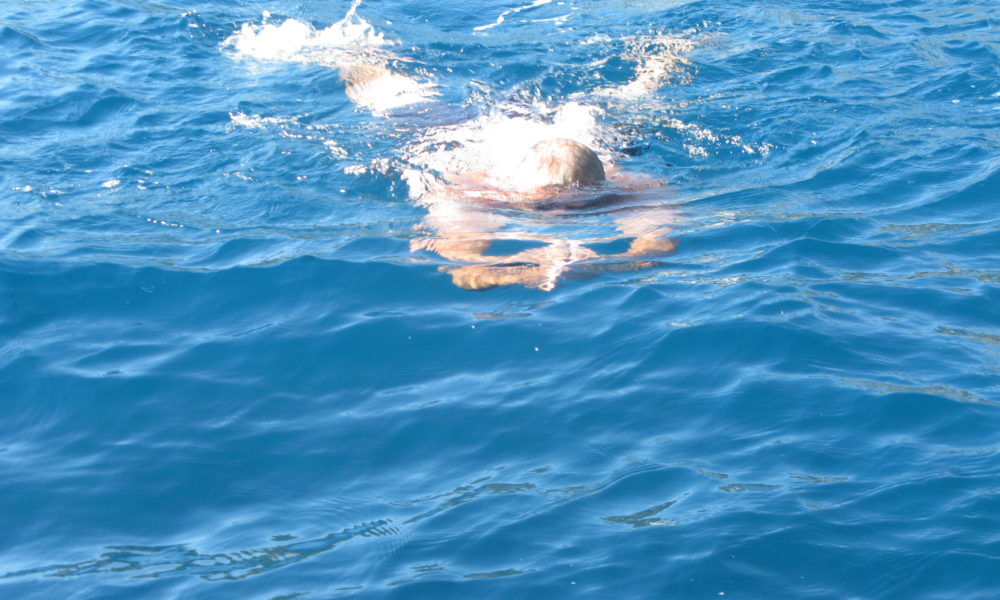
Badeferie uden badestrand – en særlig fransk livsstil?
43° 30′ 39.3696” N 7° 2′ 50.8308” E
July 23, 2016
”Dingeling, dingeling, dingeling…”
Dingeling?
Det lyder grangiveligt som en af de biler, der en gang om ugen kører op og ned ad villavejene derhjemme og sælger is fra en blå varevogn.
De biler kører vel ikke rundt i Middelhavet?
Vi ligger for anker ved øgruppen Îles de Lérins, to-tre sømil sydøst for Cannes. Øgruppen har to hovedøer, og vi har kastet ankeret i et stræde mellem netop de to øer.
På den ene side har vi Île Ste-Marguérite, hvis fort i det 17. århundrede holdt ”Manden med jernmasken” som fange (filmatiseret med Leonardo deCaprio i hovedrollen). På den anden side har vi Île St-Honorat, munkenes ø, hvor der i århundreder har boet munke, i det syvende århundrede boede der 4000 munke, i dag er kun nogle få cistercienser-munke tilbage.
Og lyden… dingeling?
Den viser sig faktisk at stamme fra et elektronisk horn på en båd, som sejler rundt og sælger is til de flere hundrede sejl- og motorbåde, der ligger for anker mellem de to øer. En isbåd – komplet med fryser, reklameskilte og prisliste for is, sandwich, kaffe, øl og sodavand.
Lidt senere kommer også en pizzabåd med et pizza-banner flagrende efter sig. Vi prajer båden og spørger, om vi kan få en med pepperoni.
”Naturellement.” Vi har alt, forsikrer pigen, der fører båden. Kig i brochuren og ring når I har bestemt jer.
Vi skal blot opgive bådens navn og nationalitet og sige, at vi ligger ”lige ud for muren”. Pizzaerne bages på en stor katamaran i nærheden, og salgsbrochuren lokker med mere end de fleste hjemlige pizzariaer: Snacks, drinks, desserter, østers, champagne, vine.
Efterhånden som vi får overblik over livet mellem øerne, viser det sig, at den kommercielle flåde omfatter to pizzabåde, tre isbåde og en enkelt båd, der sælger fisk og skaldyr. Vi venter så småt, at det næste, der dukker op, vil være en afrikansk indvandrer, der falbyder stråhatte og sarong’er til beskyttelse mod solen.
Latter, glade skrig, baderinge, snorkler, overalt tumler børn og gamle rundt i vandet omkring deres både. Strandtur uden strand. Legeland uden land.
Det er en anderledes livsstil end den, vi selv er vant til. Ikke at vi ikke ankrer op i en smuk bugt, nyder badelivet og overnatter for svaj. Selvfølgelig gør vi det. Men som regel har vi på vores sejlture i Danmark eller udlandet altid været undervejs fra A til B til C til D. En stor del af vores nydelse er at vågne op om morgenen og tænke, at i dag skal vi hen til et nyt sted, hvor vi aldrig før har været.
Mange franskmænd sejler snarere fra A til B, derefter tilbage til A. Og næste dag igen til B. Tror vi.
De bor i Cannes eller en anden by, har en båd liggende i havnen, som de bruger til at sejle ud til en skøn ankerplads, hvor de tilbringer dagen med at plaske rundt i det turkisgrønne vand. Når det bliver aften, sejler de hjem til deres faste seng. Næste dag vender de tilbage til ankerpladsen igen.
Vi gætter på, at 4-500 både i dagtimerne lå for anker i det lille stræde mellem de to øer. Da lyset brød frem den næste morgen talte vi, at præcis 53 både var tilbage og havde overnattet på ankerpladsen.
Fedt liv. Fed livsstil. Men anderledes end vores.
Efter en frisk morgendukkert på fire meter vand, tænker vi, at en gummibåd nok dukker op for at sælge morgenbrød. Men ak. Så udbygget er det maritime butiksnet trods alt ikke.
Vi trækker ankeret op, hejser sejl og sætter kurs mod bageren i Antibes.
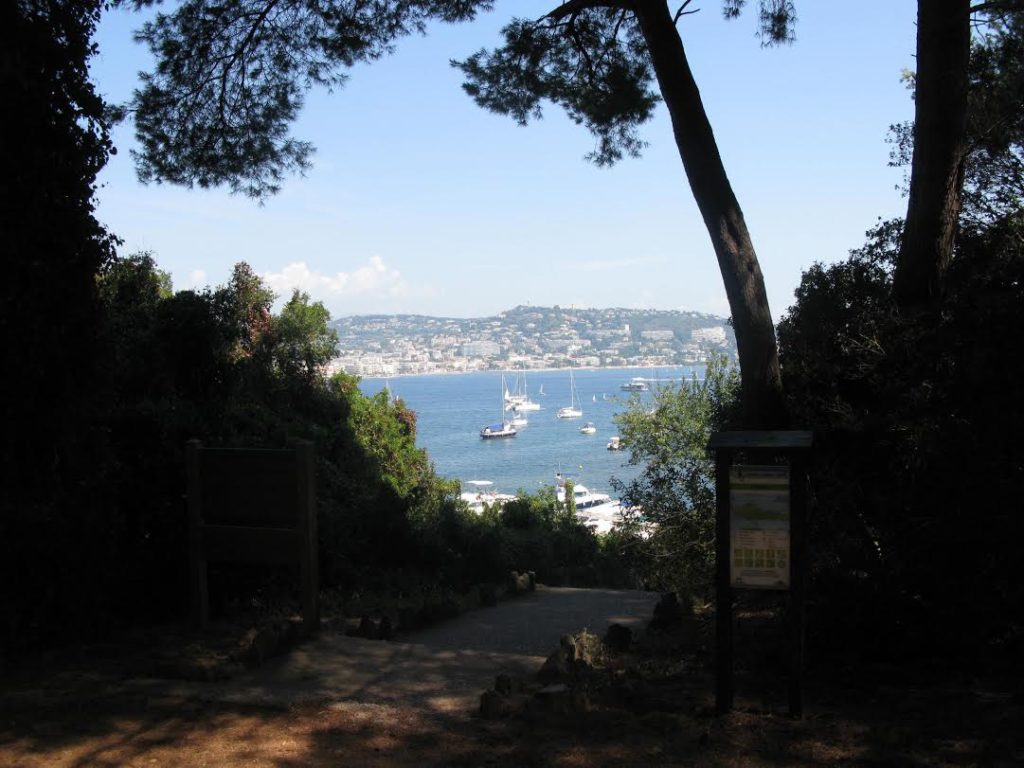
Île Ste-Marguérite er en pragtfuld ø at vandre på. Fra øens nordside er der udsigt til Cannes
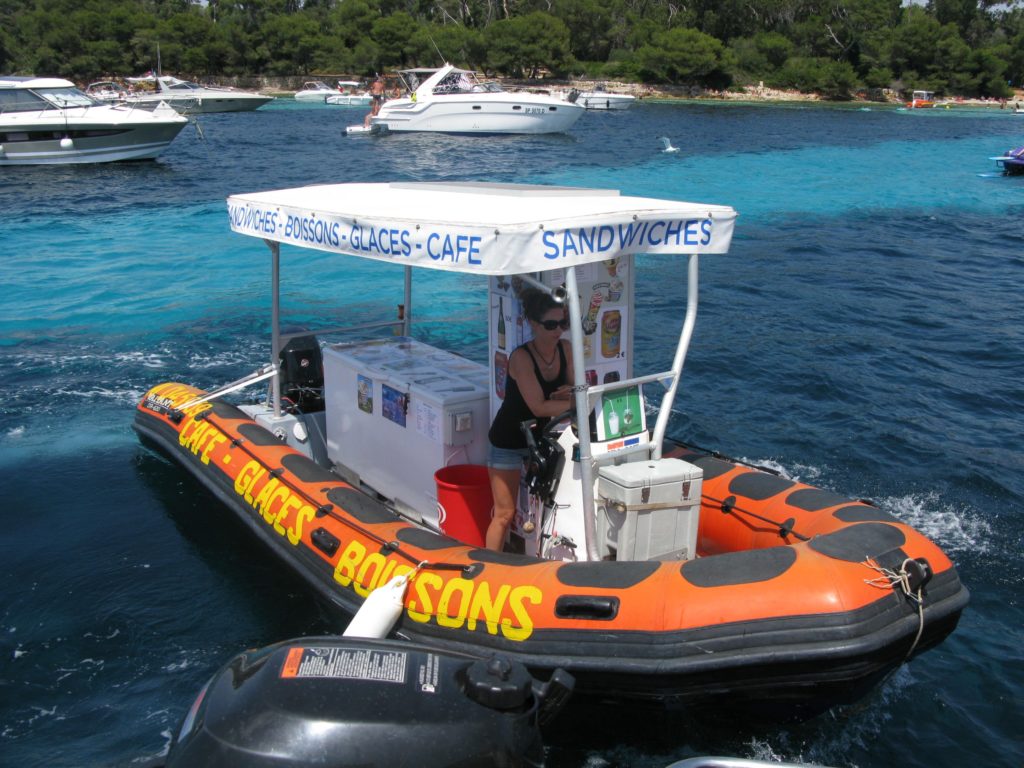
Leveret direkte til din båd: Is, kaffe, sandwich og drikkevarer
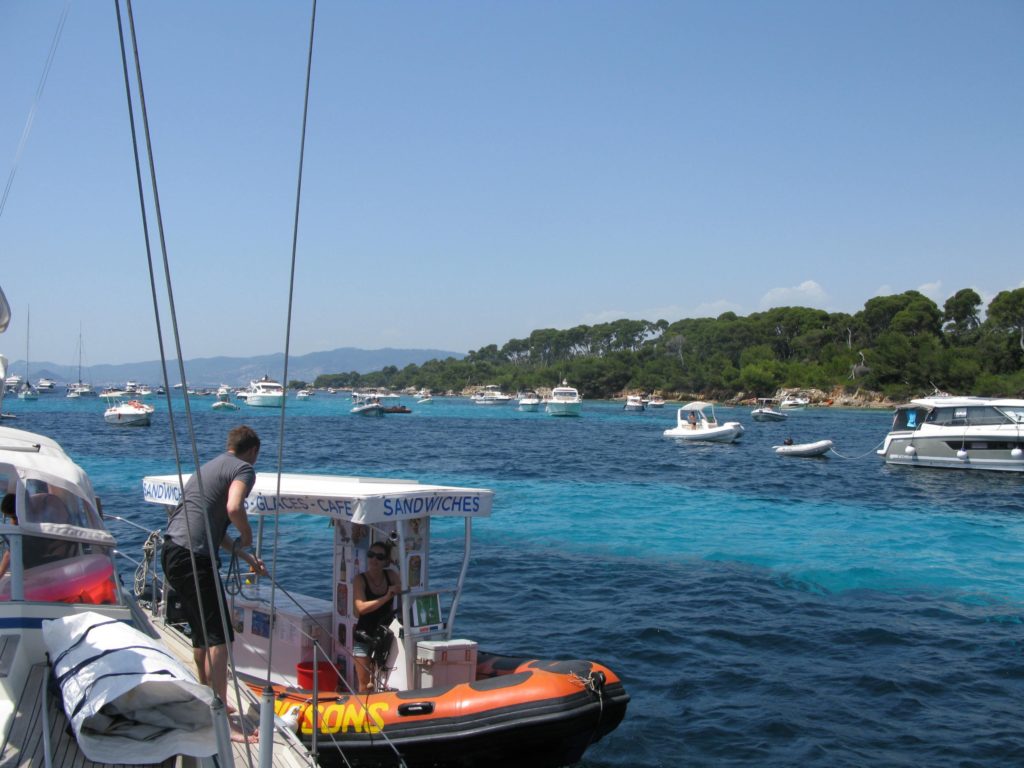
Fem Cornetto, tak. De hedder på fransk “Cone” og knap halv størrelse af dem derhjemme
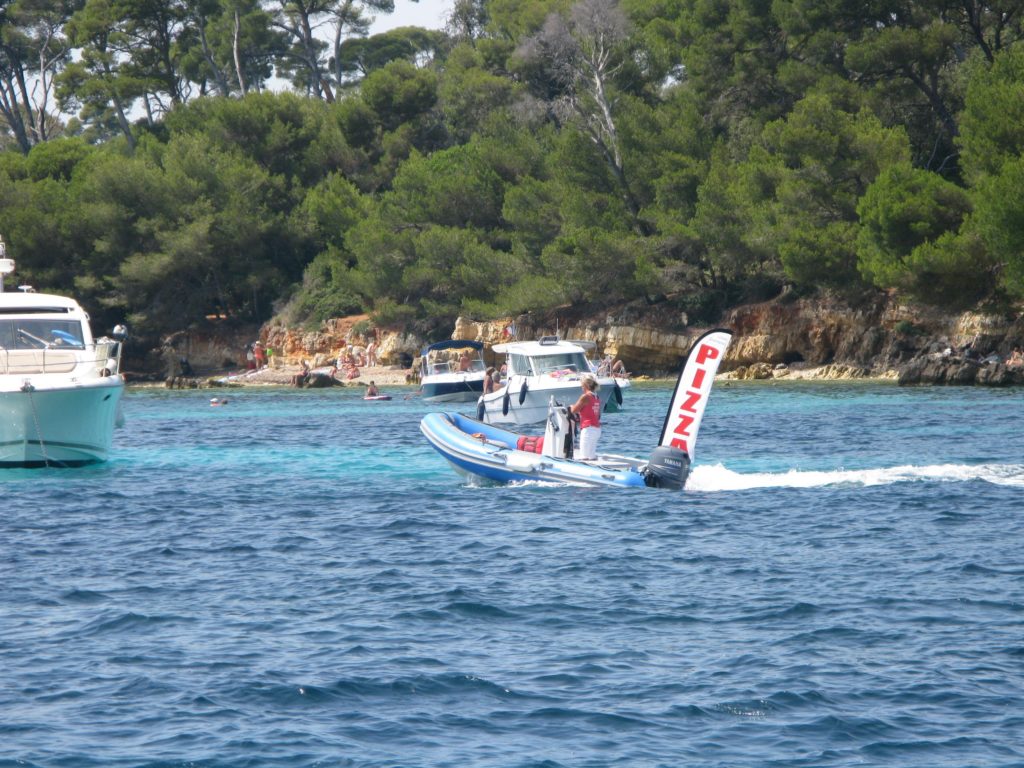
Katamaran Pizza – firmaet har to gummibåde til at levere direkte til dit skib
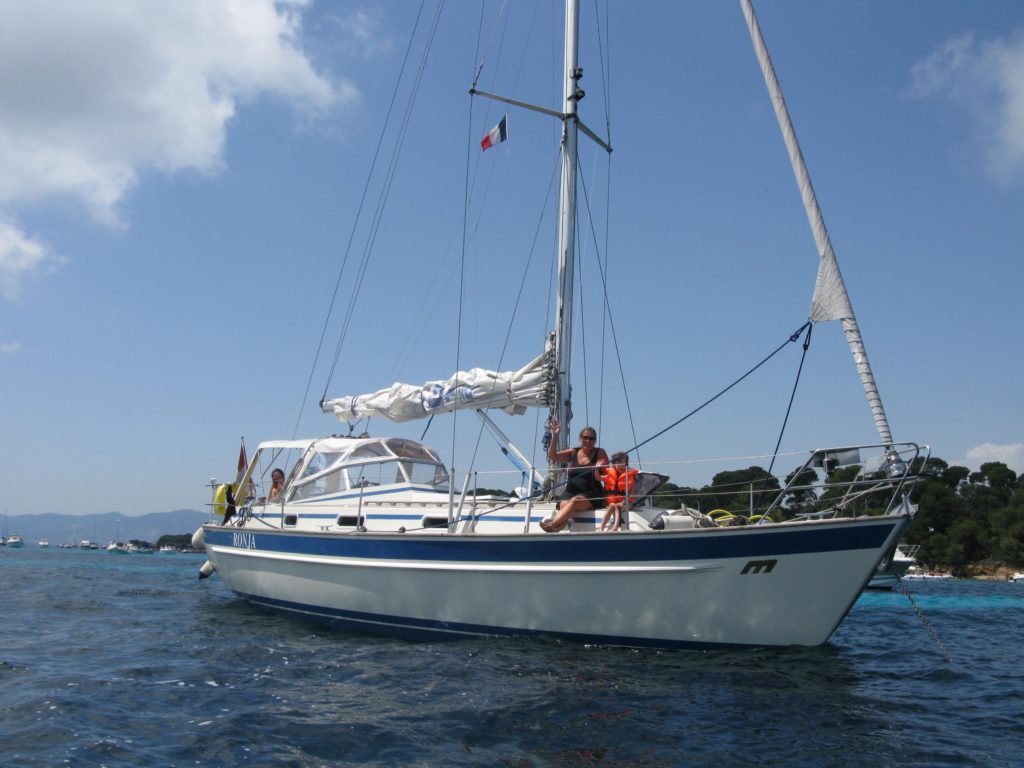
Ronja på fire meter krystalklart vand. Her med skippers kone, barnebarn Nellie og svigerdatter Tianling
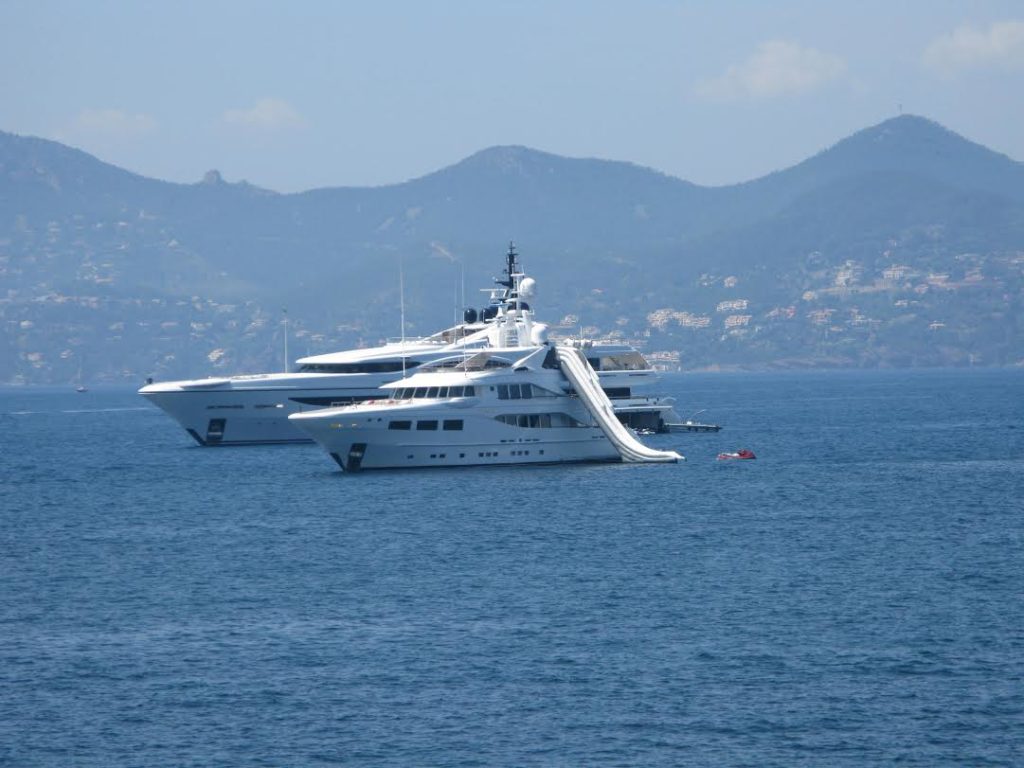
Hvad er en lystbåd uden vandrutchebane? Der kan være meget udstyr på de store yachter
Cannes slår Saint Tropez med adskillige længder
43° 33′ 10.2492” N, 7° 1′ 2.5284” E
July 16, 2016
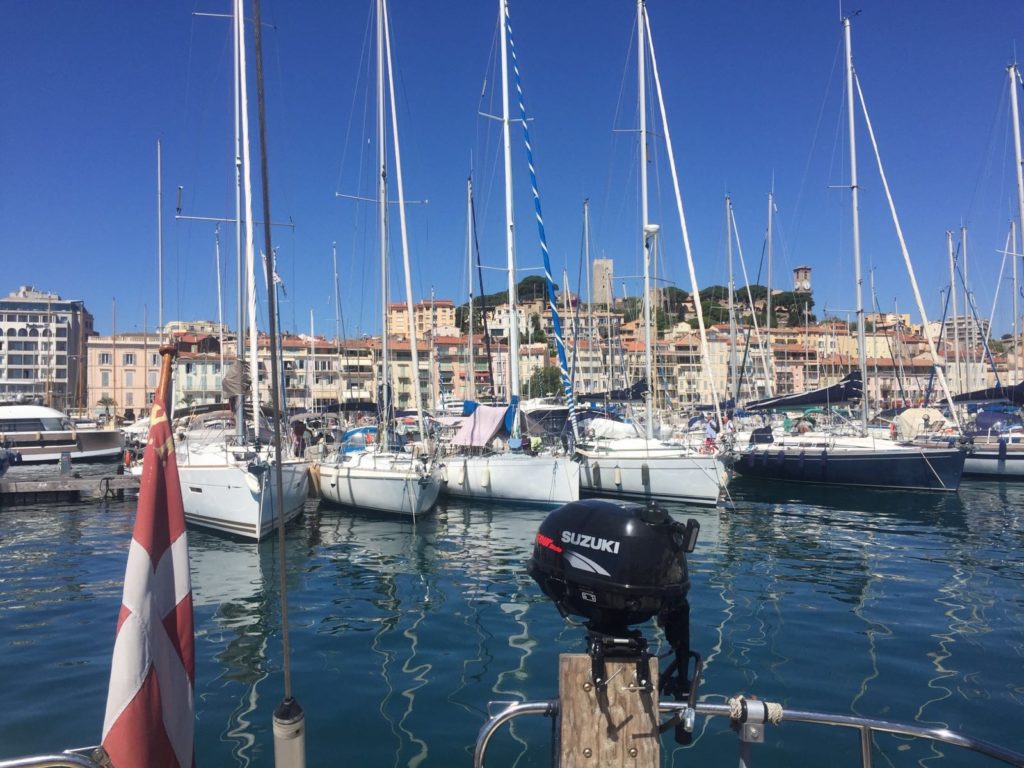
Havnefronten i Cannes udstråler mangfoldighed. Store både, små både. Her føler Ronja sig hjemme
Luften er tyk af helikoptere over Saint Tropez og Cannes. Som flittige insekter arbejder de sig summende frem og tilbage mellem byerne med lejlighedsvise afstikkere ud til de store lystyachter, der har egen helikopterplatform. Det virker som om, der især er en tæt morgen- og fyraftenstrafik af folk, der skal til og fra job fra villaen eller lystyachten i Saint Tropez, Cannes eller Nice.
Men hvad ved vi om det? Ronja har ingen helikopterplatform på agterdækket. Ved nærmere eftertanke har Ronja ikke engang et agterdæk. De mange helikoptere giver en fornemmelse af business-aktivitet, men de understreger også den stemning af eksklusivitet og ekstravagance, vi har bevæget os ind i med anløb til Saint Tropez og Cannes. Havnen i Saint Tropez gav os ly under knap tre dages sommerstorm med op til Beaufort 8 i vindstødene, og nu har vi ligget foreløbig tre dage i Cannes.
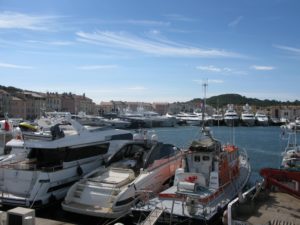
Saint Tropez: Balancen mellem tilrejsende luksus og selve byen er skæv
Af de to byer foretrækker vi Cannes. Der er fællestræk ved de to byer. Men Cannes vinder suverænt i den sammenligning. Hvorfor? Fordi der er en rarere stemning i Cannes. Cannes er ikke så forskruet, så forloren, så hysterisk som Saint Tropez. Det er som om, Saint Tropez ingenting er i sig selv, men at den snarere definerer sin egen værdi i de ting, den trækker til sig udefra – de store lystyachter, de talstærke mærkevarebutikker, de kendte og de rige.
Sådan har det vist været i mange år. Da man efter anden verdenskrig skulle genskabe den krigs-skadede by, var man bevidste om, Saint Tropez skulle dyrke et særligt ry som legeplads for de kendte. Errol Flynn kom til byen, Jean Cocteau, Anaïs Nin og i 1956 også Brigitte Bardot. Dermed var det særlige image på plads.
Det image dyrkes stadig. Turbåde sejler rundt med turister og udpeger de kendtes villaer. De store luksus-yachter får plads allerinderst i den gamle havn, så vi alle forstår, at her er den virkelige attraktion ved Saint Tropez – et smugkig ind i de ufatteligt riges verden. Turist-fædre og -sønner spadserer da også langs kajen og diskuterer, hvordan det ville være blot at arbejde på en af de enorme yachter.
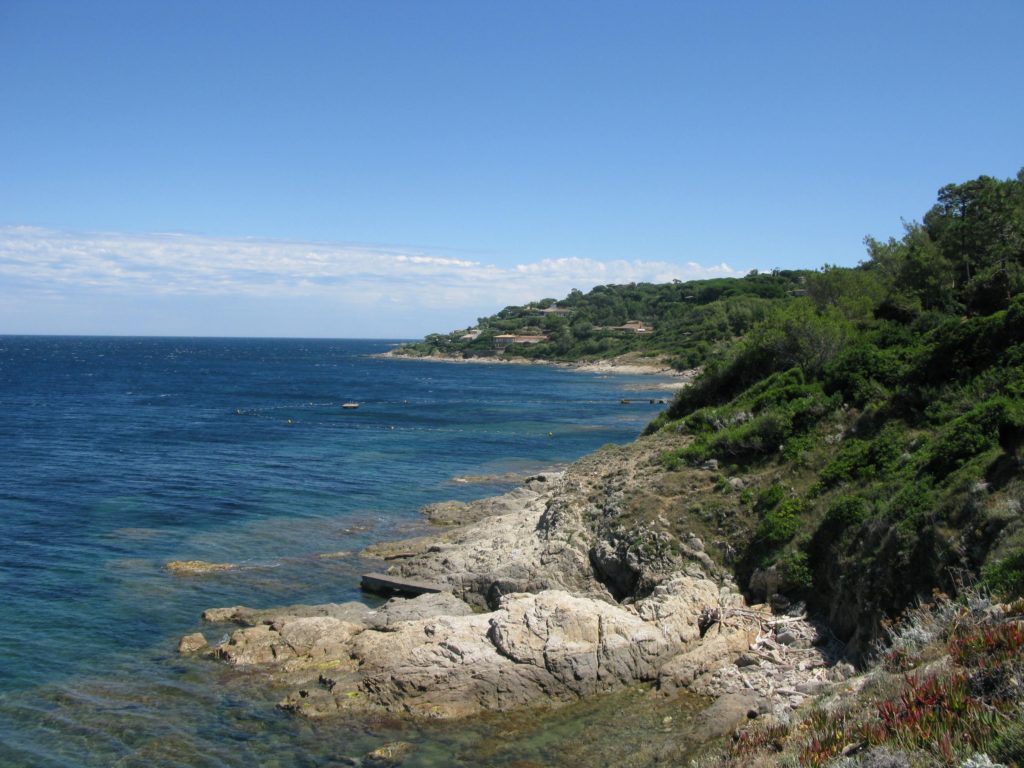
Denne vandre-tur skal du prøve. Turistkontoret fraråder den. “Den er for lang. Kør hellere i bil”. Men det er en enestående naturoplevelse.
Anderledes er det i Cannes. Her er byen større og kan bedre rumme alle ekstremerne. Her er også luksus-yachter, men de ligger ved den yderste mole og er blot ét af mange elementer i byens havn. Her er også turister, men byens størrelse sikrer, at det fortsat overvejende er en fransk by. Her er også internationale mærkevarebutikker, men de overskygger overhovedet ikke de mange, lokale specialforretninger med oste, patéer, brød, isenkram, frugt – for slet ikke at tale om antikmarkederne og det daglige, helt overdådige, fødevaremarked, Marché Forville.
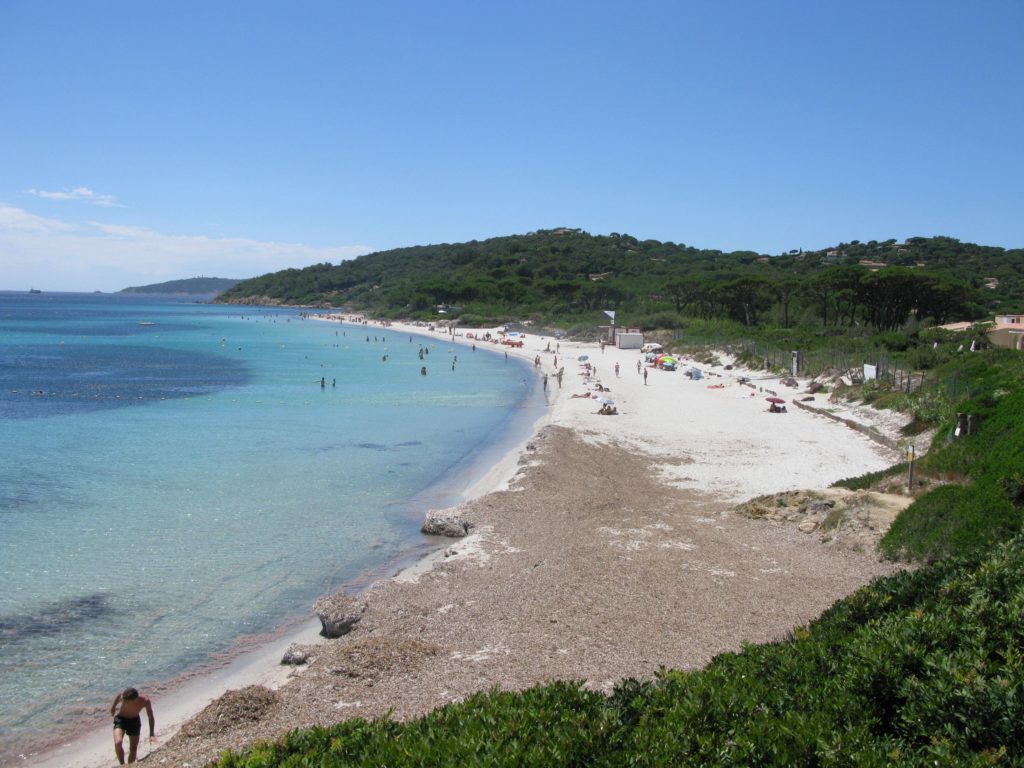
En af Saint Tropez’ strande, Les Salins. Den ligger langt fra byen men fås ikke meget bedre
Så med mindre du lige står og mangler en Gucci-taske som det første, når du anløber havn, så gælder det også indkøbsforholdene, at de er bedst i Cannes – blandt andet med et par gode supermarkeder tæt på havnen. Det bedste, vi selv oplevede i Saint Tropez, var en fabelagtig smuk vandretur på en smal klippesti rundt om halvøen fra Saint Tropez og ud til de store strande Les Salins og Pampelonne. Turen er mega-lang, der er mulighed for svømmeture undervejs, men tag rigeligt vand med hjemmefra.
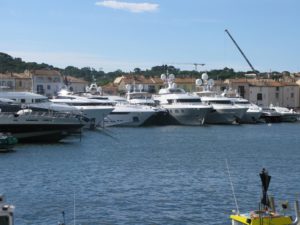
Vulgært? Helt ærligt, ja. Saint Tropez lader de gæstende luksus-yachter “skygge” for byen, som om tilrejsende rigmænd er byens egentlige attraktion
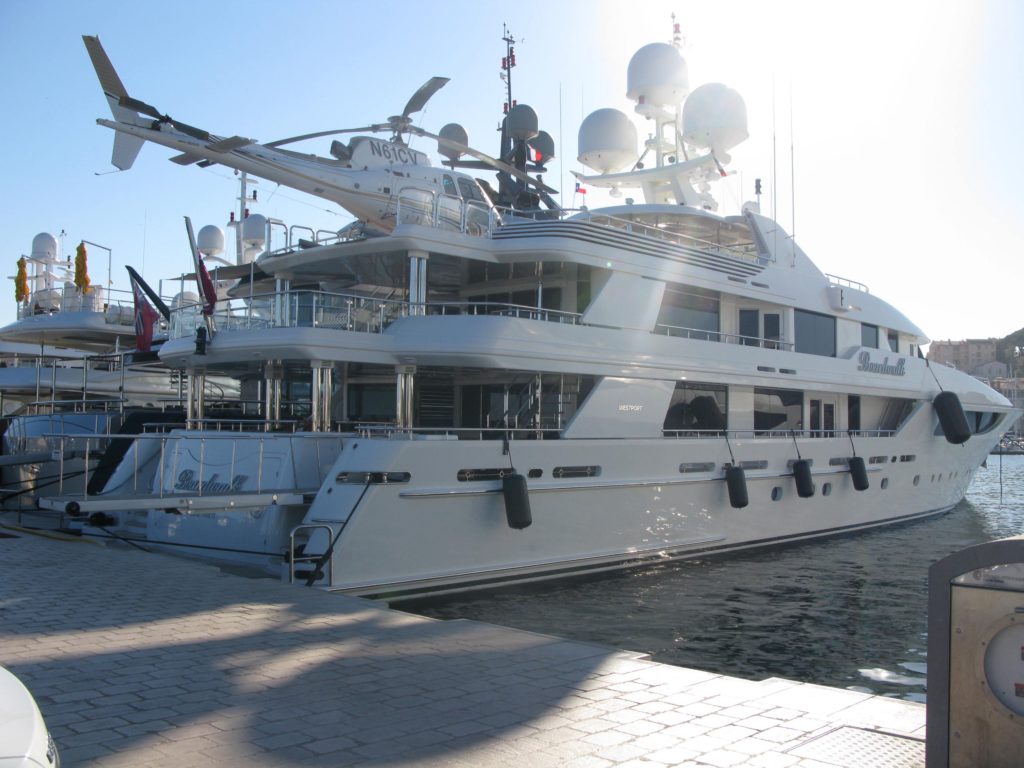
Cannes har også sin andel af de store lystbåde. Men de får ikke lov at besætte den centrale, gamle del af havnen som i St. Tropez. Det kan vi lide
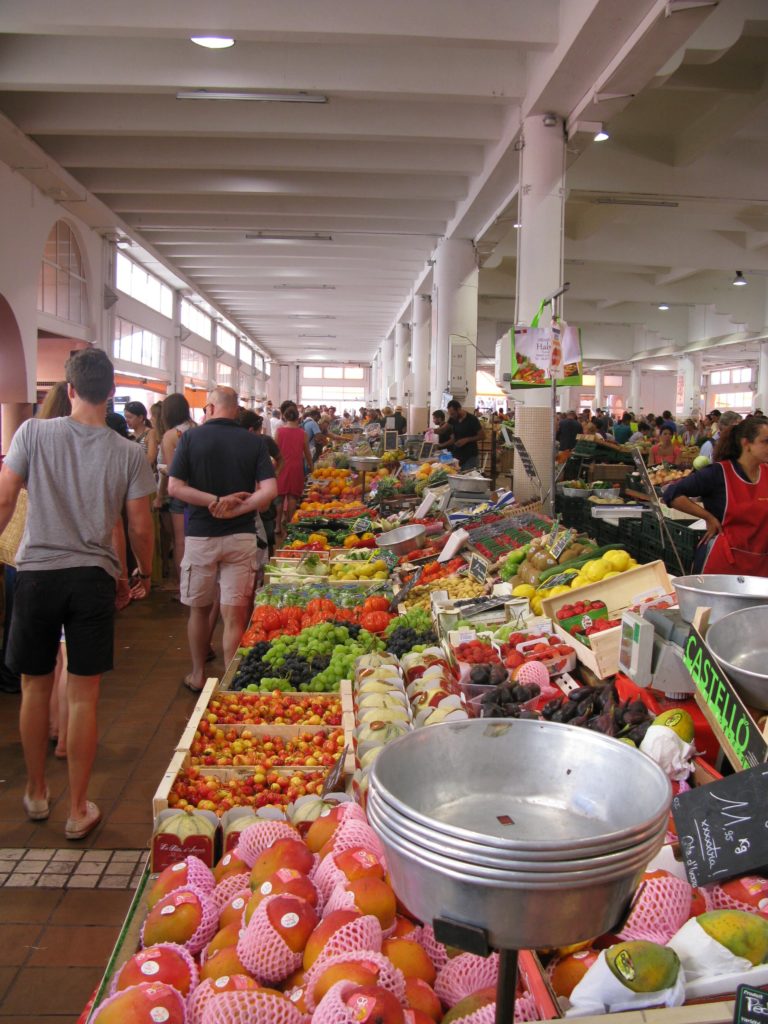
Overdådigt, fristende, lækkert. Cannes har et dagligt marked, hvor friske grøntsager, fisk, tærter og oste udbydes til priser, der ikke er specielt billige men alligevel konkurrencedygtige med supermarkederne
Fakta: En havneplads til Ronja i Saint Tropez: 59 € pr nat. En havneplads i Cannes: 34 € pr nat (med bedre faciliteter). En pizza Calzone i Saint Tropez: 18 €. En pizza Calzone i Cannes: 15 €. Saint Tropez har et lille men ganske interessant museum for moderne kunst. Det hedder l’Annonciade og entréen er 6 €.
Prisen på en ren samvittighed: 19 Euro
43° 25′ 8.8328” N 6° 51′ 29.1552” E
15. juli 2016

På jagt efter det helt rigtige azurblå hav. Når det matcher skippers kones tånegle, er vi fremme
Næppe har vi gjort Ronja fast til en ledig ankerbøje i en smuk, smuk bugt, Rade d’Agay, midtvejs mellem St. Tropez og Cannes, før en gummibåd kommer susende.
”Det bliver lige 19 Euro,” siger den unge fyr i båden.
”19 Euro? For hvad,” spørger skippers kone. ”Hvilke faciliteter får vi for de penge?”
Joh, svarer den unge fyr, der er butikker i land, der er toiletter i land, der er brusebad i land.
Men vi har ikke nogen gummibåd. Vi skal ikke i land. Vi kan slet ikke komme i land, når vi ligger her ude midt i bugten ved en bøje.
”Intet problem. Jeg kommer og henter jer for 3 € pr gang,” lyder det kækt fra havnekaptajnens driftige lærling.
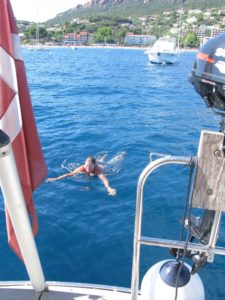
Først i vandet: Skippers kone
Det er en vidunderlig bugt. Den blev anvendt som ankerplads allerede, da romerne regerede over Middelhavet. Og i august 1944, satte amerikanerne 20.000 soldater i land netop i Agay-bugten som led i offensiven for at befri Frankrig for tyskerne. I dag er bugten præget af strand- og sejlerliv.
Senere læser vi, at det er myndighederne, der har etableret 123 ankerbøjer rundt i bugten for at beskytte en særlig art søgræs på bugtens bund (på engelsk hedder det Posidonia Grass). Det græs er vitalt for at fastholde balance og dyreliv i havet, og ved at etablere fast forankrede bøjer, forhindrer myndighederne, at den enkelte sejler roder rundt på havbunden med sit eget anker til skade søgræsset.
Nå ja. Så er 19 € måske alligevel ikke så galt.
Da vi gør klar til at lette næste morgen, prajer vi en havnevagt, der kommer forbi i sin gummibåd, vifter med en sort affaldssæk og spørger, om bortskaffelse af affald er en del af havneafgiften på 19 €.
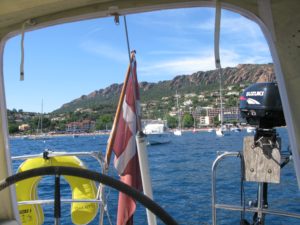
Vinden er i syd, lige ind i bugten, men under fem sekundmeter
Han peger længere ind i bugten, hvor vi godt nok har undret os over en uformelig ting, der lå fortøjet, nærmest en overdimensioneret tekop fra en Disneyland-karussel. Vi sejler derhen og minsandten: Det er en flydende skraldespand.
Lettet for det seneste døgns affald og med ren samvittighed i forhold til det vigtige søgræs, konstaterer vi, at det er så, hvad man i Agay-bugten får for 19 €.
Fakta: De 123 bøjer er anlagt i tre forskellige zoner i bugten. De, der er mere sparsommelige end vi, kan ankre uden for zonerne med deres eget anker. Det koster ingenting. Men så er der lige det med samvittigheden
Spar havnepengene og gå direkte efter stranden
43° 0′ 3.6612” N, 6° 13′ 18.0048” E
July 8, 2016
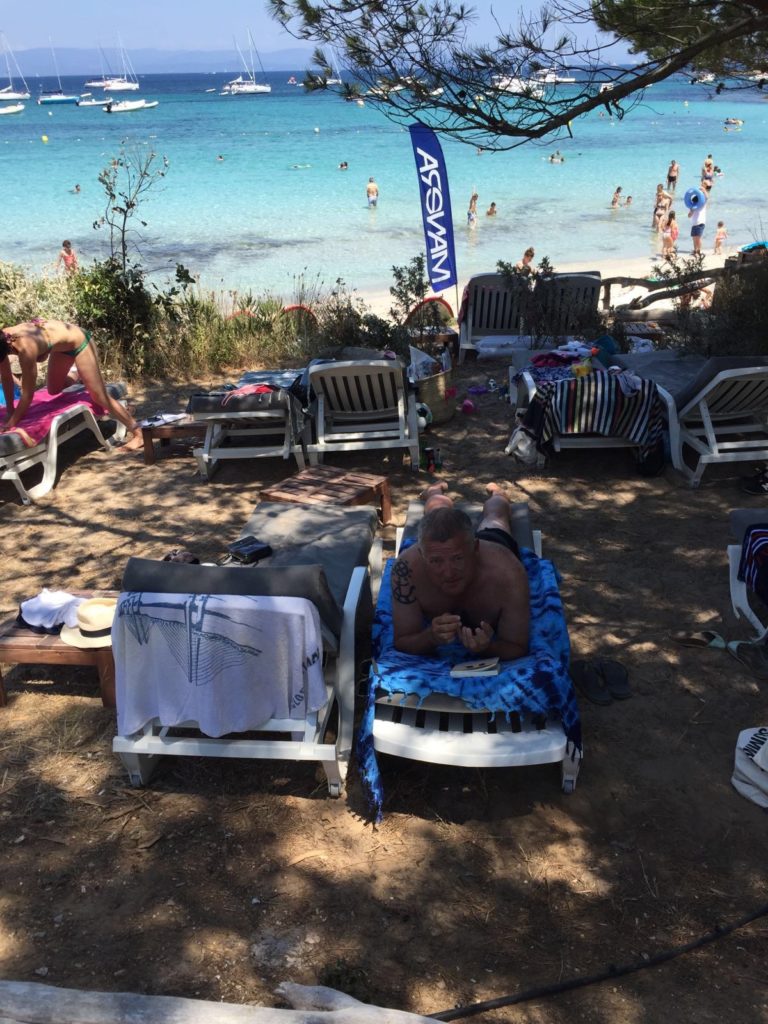
Min sjæl, hvad vil du mere?
Se det lige for dig: En blød solseng under et kæmpestort, skyggefuldt fyrretræ. En flaske koldt vand inden for rækkevidde, en krimi i hånden. Solsengen er adskilt fra det azurblå vand af ti blot meter perfekt sandstrand, og ti skridt til siden ligger en lille restaurant og lokker med dagens menu til frokost.
Stedet er Porquerolles. Den største af fire øer i øgruppen Îles d’Hyéres, et pænt stykke øst for Toulon. Porquerolles er en blanding af et Caribisk ø-paradis, fristaden Christiania i København og en kaserne. Øen tilbyder enkel ferie til skyhøje priser.
Porquerolles by blev bygget for blot 100 år siden af det franske militær. Komplet med fort, kirke, officersboliger, kaserne og træningsbaner. I dag er alle bygninger overtaget af civilister – cykeludlejere, isvaffel-sælgere, grønthandlere, bådreparatører og restauranter for enhver pengepung. Samlet er der skabt en afslappet, alternativ charme, som midt i juli får et ekstra tilskud i form af en ugelang jazz-festival.
Øens omdrejningspunkt er de mange sandstrande. Nogle har stenstrand, andre har den fineste sandstrand. Alle har sandbund i badevandet, som i øvrigt er fint adskilt fra de mange sejlere, der ligger for svaj ud for strandene. Turister til fods og på cykel tramper dagen lang askillige kilometer på vej til og fra strandene. Det kan være en varm tur, men turen er stærkt formildet af den fortryllende duft af tørre fyrrenåle og frisk saltvand.
Plage de Notre Dame har ry for at være den smukkeste af strandene. Plage de la Courtade ligger tættere byen. Vi kan dog bedst lide Plage d’Argent – for det er den eneste, der har sin egen restaurant, ordentlige toiletter og udlejning af solsenge.
Fakta: Porquerolles er latterligt dyr. Udbud og efterspørgsel er helt ude af balance. En overnatning i havnen, som har få og ringe faciliteter, kostede 50 € for Ronjas 11 meter, hvor vi er vant til at betale 35 € pr nat. En frokost-menu på restaurant kostede 24 € for en enkelt ret, hvor vi er vant til at kunne få både to og tre frokostretter for 19 € i andre havne. Bageren er dyr. Supermarkedet er dyrt. Alt er dyrt.
Et godt råd: Spar havnepengene og brug øens mange bugter til overnatning. Tag forsyninger med hjemmefra.
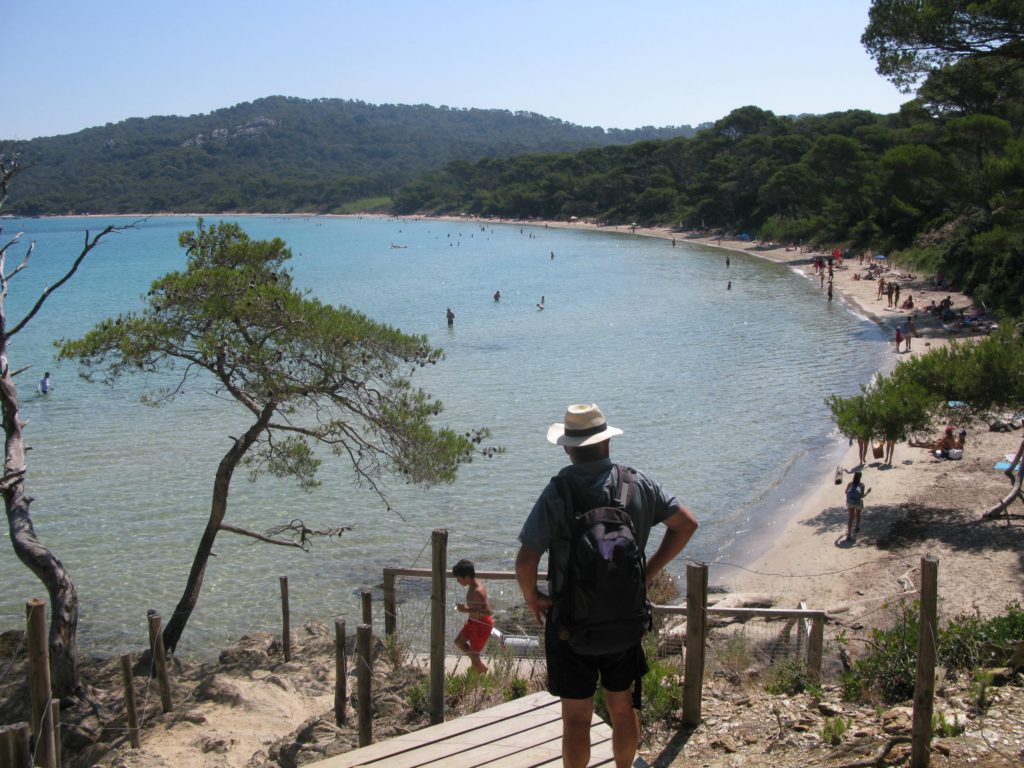
Plage Notre Dame. En øde idyl – uden restaurant
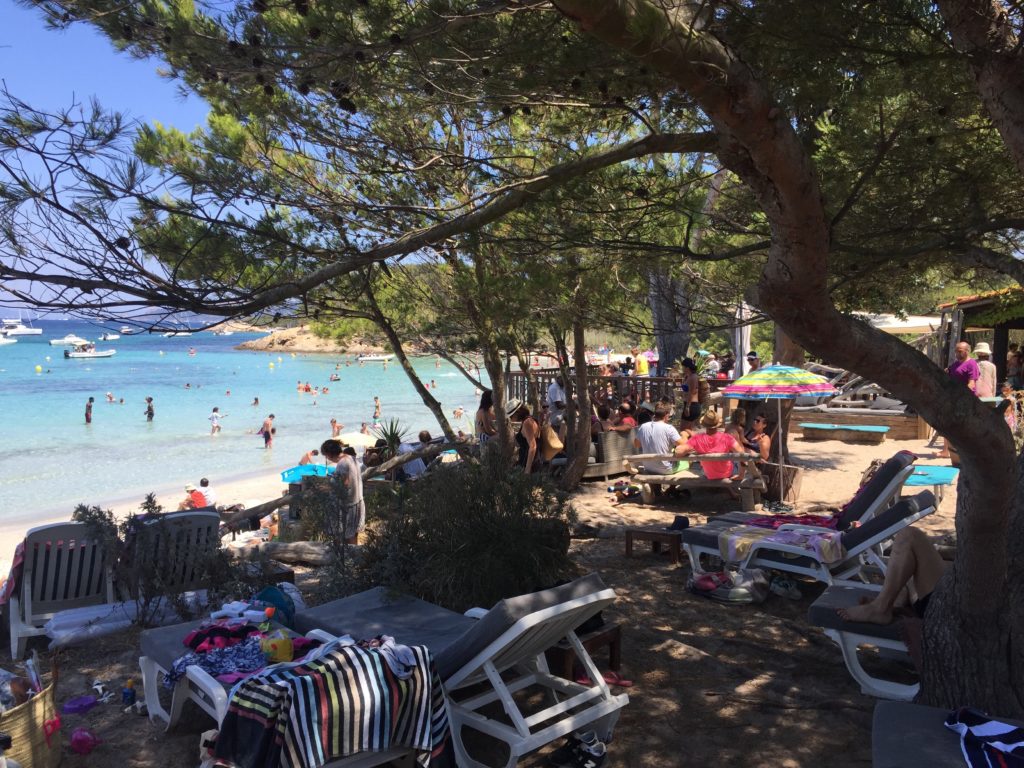
Fyrretræet er et skønt træ. Skygge, duft og tørhed
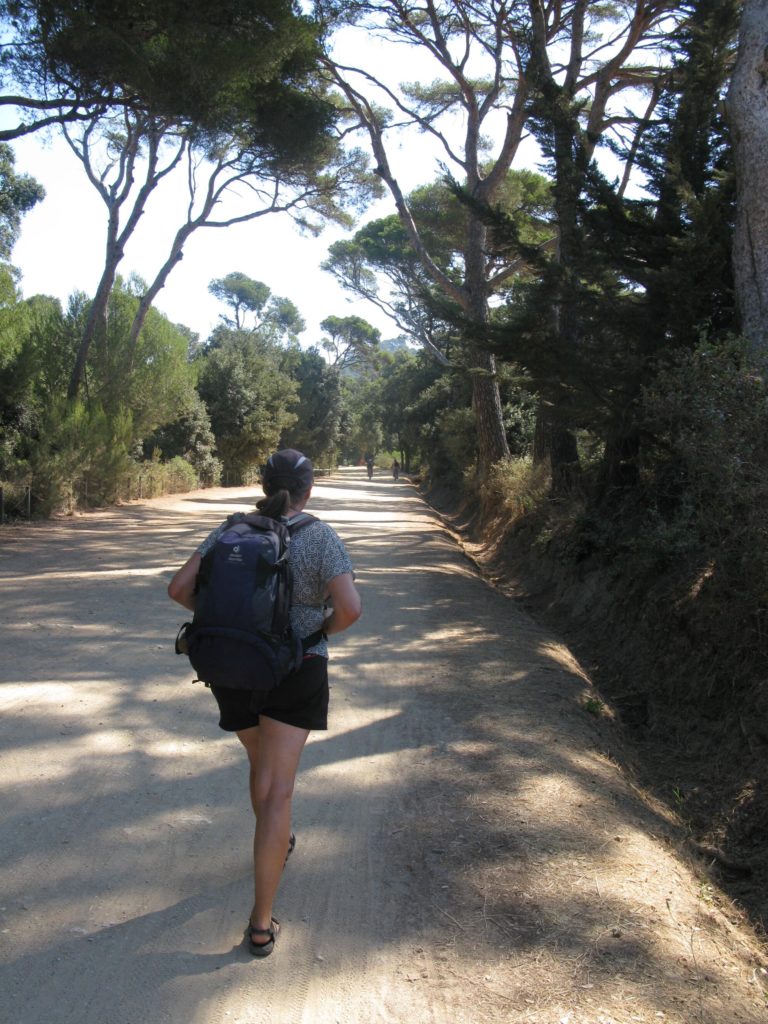
Skippers kone på vej mod Plage Notre Dame. Igen med fyrretræer som fin kulisse
Byer skal have sjæl – ellers sejler vi videre
43° 7′ 14.82″ N, 5° 48′ 15.79″ E
July 7, 2016
Franskmænd har det svært med navnet på vores båd, ”Ronja”. I Sanary-sur-mer har vi på forhånd meldt vores ankomst via mobiltelefon, men da vi træder ind på havnekaptajnens kontor, er der ingen genkendelse, da jeg staver til ”Ronja”.
Den, der har taget imod telefonen, har skrevet vores navn ned som ”Oneyeah”. Kendskabet til Astrid Lindgrens forfatterskab generelt og Ronja Røverdatter specielt er ikke stort i Sydfrankrig.
Til gengæld er Sanary-sur-mer et særdeles fint bekendtskab. Den er naboby til den mere kendte by, Bandol. Men vi bilder os ind, at det er en mere helstøbt by. Den er smuk på den der Provence-måde med beige, okkergule, hvide, støvede bygninger afbrudt af skrappe grønne eller blå skodder for vinduerne. Byen har fiskeri, dagligt fiskemarked, smuk natur, befriende få mærkevarebutikker og en glimrende strand. Der er sådan lidt ”Folk og røvere i Kardemomme by” over den. Med tårn og det hele.
Byen har sjæl. Man fornemmer, at der er liv, også når turisterne er rejst hjem. Byen har kulturelle, arkitektoniske, historiske, erhvervsmæssige og landskabsmæssige værdier, der ikke skvatter sammen i perioder, hvor kun de faste beboere er tilbage.
Den slags – at en by har sjæl – er ingen given ting på disse kanter. Nogle dage senere anløber vi Cavaliere-sur-mer, som i den grad skuffer. Fin havn, gode faciliteter, alt er nydeligt. Men Cavaliere-sur-mer er åbenlyst en by, der lever og ånder med turismen og ikke meget andet.
Tæt på havnen er opført et helt nyt forlystelseskvarter bestående af 20-30 restauranter og natklubber plus en enkelt karussel. Der festes til langt ud på natten, men det er svært at forestille sig byen som andet end en spøgelsesby, når strandturisterne er rejst hjem.
Lyder vi, som om vi er mavesure over at have fortøjet Ronja midt i et blinkende diskotek? Tja, det spiller nok også ind.
Paradis på jord – Calanque de Port-Miou
43° 12′ 20.16″ N, 5° 30′ 55.01″ E
July 5, 2016
Indtil denne dag anede vi ikke, hvad en Calanque var. Det ved vi nu. Og vi er begejstrede.
En calanque er en bugt eller – i den mest spændende udgave – en snæver og dyb fjord, som skærer sig ind i et klippelandskab, så siderne er nærmest lodrette og kan være op til 100 meter høje. Når man er inde i en sådan calanque, føles det lidt som at sejle i en katedral. Andægtigt kigger vi op og på de stejle klippesider, nyder duften af fyrretræer og lytter til cikadernes hymne.
Vi sejlede ind i dem alle, lige fra de første dukkede op nogle sømil efter Marseille. Efter at have tjekket dem alle, valgte vi at slå os ned i – synes vi selv – den aller mest charmerende: Calangue de Port-Miou.
Enkelte calanquer er småkedelige, ikke meget andet end en bred vig med en stump strand i bunden. Men jo tættere vi kommer på byen Cassis, bliver calanquerne dybere og mere karakterfulde. Først Sormiou, derpå Morgiou og senere Calanque d’En-Vau og Calanque de Port Pin. De er på hver deres måde spændende. Men ingen kan måle sig med Calanque de Port-Miou.
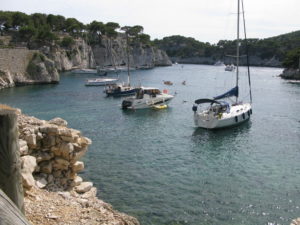
I det forreste “rum” er der plads til 20-30 overnattende både. Men de må leve med en konstant trafik af store turistbåde, der besøger calanquen
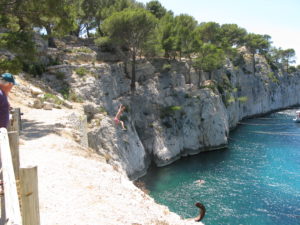
Port-Miou var engang et stenbrud, der leverede sten til Suez-kanalen og til de smukke bygninger i Marseille. Nu bliver bruddet brugt af lokale vovehalse
Ved første blik virker Port-Miou blot til at være større end de andre med flere pladser til fortøjning af både – med en ankerbøje i den ene ende og et reb snurret rundt om et klippefremspring eller i heldigste fald en ring i den anden ende. Men det er kun ved første blik. Pout-Miou har en slags forreste rum, hvor der er plads til 20-30 både, og hvor der er et leben af turbåde dagen lang fra de større byer i nærheden, der sender turister ud, mens guider fortæller om calanquerne.
Tricket er at sejle videre. Helt ind i bunden af det forreste rum, for her åbenbarer sig endnu et rum – meget smallere, meget længere, ja, nærmest svimlende langt, næsten en kilometer. På hver side af denne snævre kløft er der bygget en “catwalk”, en spinkel træbro, i begge sider. Og her har hundredevis af lokale både deres faste liggeplads. Som i et hemmeligt kammer.
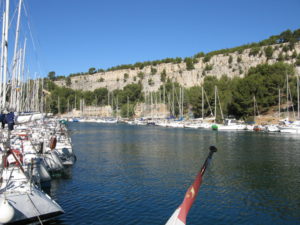
Cikader, fyrretræer, køligt vand og stilhed. Hvad mere kan du ønske dig?
Da vi kalder havnekaptajnen på VHF, kanal 09, og spørger om plads, henviser han os til det forreste rum. Det har vi ikke lyst til. ”Vi kan se, at der er ledige pladser ved broerne,” insisterer vi. En gummibåd dukker op, og vi får en plads. Alligevel. En vidunderlig plads. Tæt på paradis. Vandet i den smalle kløft er koldt og rent og perfekt til at køle kroppen under den ubarmhjertige sol. Der er stille. Ikke en lyd fra turbådene i det forreste rum. Kun cikader. Lejlighedsvist et par kajaksejlere eller en enkelt franskmand, der klargør sin båd.
Fakta: Det er primitivt. Men franskmændende forstår den kommercielle værdi af skønhed, så prisen for en overnatning i Port-Miou er nogenlunde som i Marseille, godt 35 €. Det er uden el, vanskelig adgang til vandtilslutning og et kvarters spadseretur ad en smal gangbro til bad og toilet på den anden side af kløften. Indkøb sker med 25 minutters vandretur til byen Cassis, hvor der dog er både bus og minitog, til dem, der ikke orker at gå.
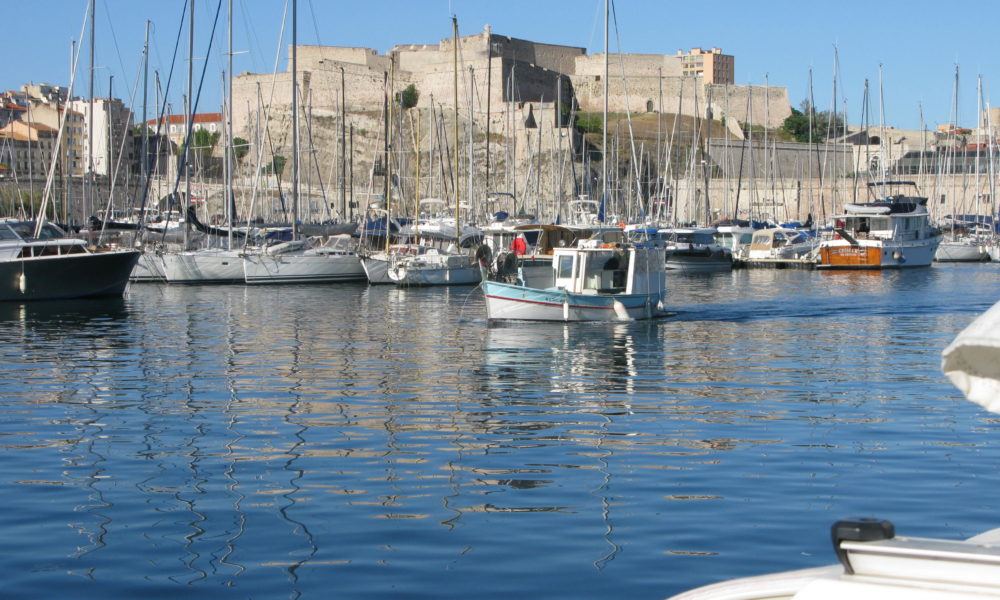
Stemme fra det høje – velkommen til Marseille!
43° 17′ 47″ N 5° 22′ 12″ E
July 2, 2016
”Ronja!”
Navnet på vores båd tordner ned over os.
En stemme fra himlen? Eller en stemme fra havnekaptajnen, der råber gennem en kraftig højttaler? Vi er netop gledet ind mellem de to imponerende fæstninger, der markerer indsejlingen til Marseilles fantastiske havn, Vieux Port. Vi skeler ængsteligt op mod himlen.
Stemmen fortsætter: ”Ronja. Bliv midt i bassinet. I bliver hentet af en gummibåd!” . Det har været en forrygende sejlerdag. Den første rigtige sejlerdag, efter at Ronja i flere somre har arbejdet sig gennem de franske floder og kanaler alene for motor og uden mast (masten var kørt i forvejen på en blokvogn med en tysk vognmand).
Nu er Ronja genforenet med sin mast, og har fået svimlende meget vand under kølen. Mistralen gav os fra morgenstunden et kærligt puf bagi med en agten for tværs i Beaufort 6-klasse. For fulde sejl fra Port Saint Louis du Rhone. Og nu er vi i Marseilles
… hos stemmen fra det høje. En gummibåd kommer susende med en havnekaptajn og to hjælpere ombord. Hvor længe har I tænkt jer at være hos os, vil havnekaptajnen vide. Da vi siger to-tre dage, ser han skeptisk ud. Lidt lige som når man kommer ind på en restaurant og må erkende, at man ikke på forhånd har bestilt bord.
Hans mimik lader os forstå, at det vil blive meget svært. En næsten uløselig opgave. ”Følg os”, siger han. Og så har vi balladen.
Ikke én af de knap 1000 både i Vieux Port ligger med stævnen ind mod broen, sådan som vi er vant til i Danmark. Samtlige både – og jeg mener virkelig samtlige – vender agterenden ind mod broen. De bakker ind! De er skøre, de franskmænd. Den slags bruger vi ikke hos os. Intuitivt er vi imod. Vores båd er relativt langkølet og manøvrerer klart dårligere baglæns end forlæns. Og hvorfor skal alle partout ligge cockpit ved cockpit ind mod broen, så alle kan følge med i hinandens middags-menu?
Nogen skøn manøvre bliver det da heller ikke. Ronjas badeplatform kiler sig ind under ponton-broen, og en af de faste liner, som vi ifølge samme aparte franske tradition skal samle op fra havnebunden og fastgøre stævnen med, går i bekneb. Havnekaptajnen råber, at vi skal bakke, så hans line kan komme fri. Hans hjælpere fniser.
Ronjas skipper nægter at bakke yderligere ind mod ponton-broen af hensyn til den klemte badeplatform. Det hele løser sig. Det gør det som regel. Men der er altså et eller andet med franskmænd og arrogance. De opfinder en tåbelig fortøjnings-teknik, pålægger alle at anvende den – som var det et statsligt dekret – og så tillader de sig ovenikøbet af smiske åbenlyst over de uheldige udlændinge, der ikke kan finde ud af at anløbe deres havn.
Men sikke en plads. Sikke en udsigt. Sikke en by. Alle burde prøve at ligge midt i Marseilles centrale havn og nyde det særlige lys, de smukke bygninger, pariserhjulet, den flotte kirke på bjerget, den afslappede stemning fra caféer og restauranter, som omkranser hele havnen og samtidig nyde den intense energi, der bliver skabt gennem daglig fiskemarkeder, andre markeder samt en endeløs ind- og udsejling af fiskere, udflugtsbåde og lystsejlere.
Marseille er en underkendt by. Den har stadig et ry af mafia, narko og anden kriminalitet over sig. Men byen har oppet sig. Der er renoveret og bygget nyt. Der er skabt arkitektoniske mesterværker i form af nye museer og nyindrettede indkøbscentre i gamle pakhuse. Norman Forster har skabt overdækningen til havnens metrostation. Fascinerende. Kriminaliteten er der muligvis stadig, men den er i så fald trukket i jakkesæt, og lever en mere diskret tilværelse end den, vi kender fra Gene “popeye” Hackmanns fortrædeligheder i filmene ”French Connection I og II”.
Marseille er en super spændende by. Storladen, pulserende, charmerende og fransk – med et betydeligt tilskud af indvandrere fra de nordafrikanske lande. Man møder kun få turister fra Tyskland, Storbritannien og Skandinavien. Marseille er en fransk storby. Indtil videre fortrinsvis for franskmændene selv.
Der er ikke andet end godt at sige om Marseille. … ja, det skulle da lige være havnekaptajnens sygelige insisteren på, at alle både skal vende ens ved samtlige broer i havnebassinet. Enten er det sindssyg æstetik, eller også er det et fascistisk ønske om, at vi alle skal marchere ens og i takt.
Fakta: Det kostede 35 € pr nat at overnatte i Vieux Port. El og vand lige ud for båden. Unik beliggenhed men en del larm om natten. Toiletter og bad nærmest utilgængelige – de ligger på den anden side af havnen, en spadseretur på halvanden kilometer. Havnekaptajnen nævnte, at vi blot kunne ringe, så ville han hente os i sin gummibåd, når vi skulle bruge badet. Men ærlig talt: Vi kom fra starten lidt skævt ind på den havnekaptajn.
Atter i Frankrig. Klar til Middelhavet
43° 23′ 15″ N, 4° 48′ 15.84″ E
Juni 29, 2016
Vores chauffør er helt oppe i det røde felt. Kan de kvinder ikke flytte deres bil, så han kan komme forbi? Fjolser! Han åbner bilens vindue, råber til de to kvinder, at de skal køre ind på en parkeringsplads, så han kan komme forbi.
Han har ikke helt forstået situationen.
De to kvinder er bakket ud fra deres parkeringsbås præcis samtidig med vores chauffør, og de lægger an til at køre den ene vej, mens han lægger an til at køre den anden vej. Nu er det køler mod køler. Den ene kvinde stiger ud af bilen og forklarer, at denne vej er ensrettet, og at han er på vej i den forkerte retning. Derfor skal han give plads til, at de kan fortsætte. Han fnyser. Kvinder. ”Oh, la, la”. Med hånden viser han, at netop disse kvinder i særklasse er uden for rækkevidde.
”Je suis importante”, siger han i et sidste forsøg på at vinde kampen. ”Jeg er betydningsfuld”. Det gør ikke indtryk. Vores chauffør kører bandende tilbage på sin plads, lader kvinderne passere og kører ud igen, mens han mumler om amatører, kvinder, folk uden respekt for autoriteter og færdselsregler.
Kirsten og jeg sidder i passagersæderne og ser, hvordan store pile i kørebanen viser, at det var de to kvinder, der havde ret. Vores chauffør er et fjols.
Og vi er tilbage i Frankrig. Klar til at genoptage vores ”jordomsejling i etaper” med det gode skib Ronja. En svenskbygget Malö 36, skøn, smuk og solid. De seneste 11 måneder har hun været parkeret på land 50 kilometer vest for Marseille. Hos Navy Service i Port Saint Louis du Rhone. Vores fjols af en chauffør har netop hentet os i ankomsthallen i Marseille Lufthavn med sit skilt fra Navy Service: ”Mr. Jensen”. Det er os.
Han er givetvis 80+, ligner en sur julemand med hvidt skæg og uindfattede briller, taler kun fransk og har sandsynligvis overskredet sidste brugsdato på sit kørebevis. Da vi kom ud fra ankomsthallen til lufthavnens parkeringsplads, kunne han ikke huske, hvor han havde sat sin bil. Vent lige her, sagde han og cirklede planløst rundt. Suk. Hvem er vi i gang med at betro vores liv her?
Han finder bilen, vi smider vores to bløde tasker ind bagi – og så kommer de to kvinder og insisterer på deres ret. Det er ikke hans dag, chaufførens.
Navy Service er et fedt sted. De har 1200 både i vinteropbevaring på land. De har specialiseret sig i at løfte skibe på land, parkere dem og senere – efter nogle måneder – at sætte dem i vandet igen. Andet kan de ikke. De betjener kraner – mastekraner og skibskraner. Det er de til gengæld gode til.
På området lever – som små parasitter – en halv snes små, selvstændige håndværksfirmaer. Nogle af disse kan vintersikre din motor, andre kan reparere epoxyskader, andre kan sy dit storm- og kuldeafvisende, nordiske cockpittelt om til en let og luftig, middelhavs-bimini. Det er dyrt. Men for pokker, det er dejligt.
Jeg tænker, det er en fransk specialitet: Port du sec. Tørre havne. Store asfalterede eller grusbelagte områder, hvor franskmænd og globetrottere lader deres både vinteropbevare med masterne på. Det skåner båden mod begroning, lader dem tørre ud og passer fint til dem, der alligevel kun har en sejlsæson på et par måneder.
Selv med håndværkere til hjælp glemmer vi sejlere ofte, hvor meget arbejde, der skal til, for at gøre en sejlbåd sejlklar. Masten skal renses. Vant og stag skal justeres. Elektriske installationer mellem mast og båd skal genetableres. Pærer skal skiftes. Afløb skal renses. Sejl skal sættes på. Defekte dele udskiftes. Alt skal have en omgang Ajax. Vand og mad skal bunkres. Det tager dage.
Mere tid end man sådan lige går rundt og husker. Vi får det hele gjort, selv om solen over Rhone-deltaet er ubarmhjertig. Vi sveder, arbejder helst tidligt morgen og sent aften, og om natten kæmper vi med myggene. Mens vi arbejder får vi af og til et glimt af vores chauffør fra lufthavnen. Han fungerer tilsyneladende også som pladsmand hos Navy Service. I dag kører han gaffeltruck, flytter containere og store skraldespande med et sammenbidt udtryk. Ingen skal komme i vejen for ham. Ingen.
